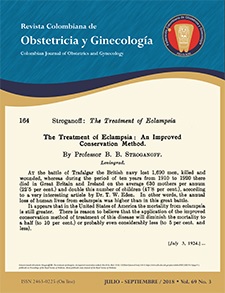The current approach to preclampsia
DOI:
https://doi.org/10.18597/rcog.3248Abstract
In Ancient Greece the believe was that the human body was made up of four types of humors, and any imbalances among them resulted in illness. Women were thought to be more vulnerable to disease because of an overproduction of fluids and due to the presence of a “wandering womb” that could invade her various organs and even cause seizures during pregnancy (1). Hippocrates, the father of medicine, thought that seizures during pregnancy were the result of blood congestion or depletion in the brain (2).
During the Middle Ages religious believes prevailed; charms, magical concoctions, and prayers for healing were used (1). In an attempt to reduce cerebral congestion and prevent eclampsia, Mauriceau recommended performing between two and three phlebotomies during pregnancy, and overstated in his writings the critical nature of the disease (3).
By the end of the 19th Century and early in the 20th Century, physicians in Germany and the Netherlands managed preeclampsia aggressively, delivering the fetus immediately, either vaginally or abdominally. This aggressive obstetric approach dramatically increased maternal mortality. Consequently, the conservative management of preeclampsia gained popularity (4). The pioneers of this method were Tweedy in Dublin and Stroganoff in Russia (1). The former considered that hastening of labor and delivery increased the occurrence of seizures due to reflex mechanisms. The physician should refrain from conducting any vaginal examinations, abdominal palpation, and cervical dilatation. The patient was sedated with high doses of morphine and if the patient went into labor, the application of forceps was permissible (5).
Author Biographies
Carmen Doris Garzón-Olivares
Profesor asociado del departamento de obstetricia y ginecología, Facultad de Medicina, Universidad Nacional de Colombia. Bogotá, Colombia.
Alejandro A. Bautista-Charry
Director del departamento de obstetricia y ginecología. Facultad de Medicina, Universidad Nacional de Colombia. Bogotá, Colombia.
References
Bell MJ. A historical overview of preeclampsia-eclampsia. J Obstet Gynecol Neonatal Nurs. 2010;39:510-8. https://doi.org/10.1111/j.1552-6909.2010.01172.x
Salas S. What causes pre-eclampsia? Baillieres Best Pract Res Clin Obstet Gynaecol. 1999;13:41-57. https://doi.org/10.1053/beog.1999.0005
McMillen S. Eclampsia. En: Kiple KF, editor. The Cambridge Historical Dictionary of Disease. New York: Cambridge University Press; 2003. p. 110-112.
Chesley LC. Hypertensive Disorders in Pregnancy. New York: Appleton-Century-Crofts; 1978. p. 309-317.
Tweedy EH. Eclampsia. Trans Roy Acad Med, Ireland. 1896;14:272-84. https://doi.org/10.1007/BF03170691
Speert H, editor. Vasili Vasielievich Stoganov and his eclamptic regimen. En: Obstetrics Gynecologic Milestones. New York: The Parthenon Publishing Group; 1996. p. 582-586.
Stroganov V. The improved prophylactic method in the treatment of eclampsia. New York: William Wood and Company; 1930.
Lazard EM. A preliminary report on the intravenous use magnesium sulphate in puerperal eclampsia. Am J Obstet Gynecol; 1925;9:178-88. https://doi.org/10.1016/S0002-9378(25)90068-3.
Zuspan FP, Ward MC. Treatment of eclampsia. South Med J. 1964;57:954-9. https://doi.org/10.1097/00007611-196408000-00019.
Pritchard JA. Standardized treatment of 154 consecutives cases of eclampsia. Am J Obstet Gynecol. 1975;123:543-9. https://doi.org/10.1016/0002-9378(75)90042-3.
Sibai BM, McCubbin JH, Anderson GD, Lipshitz J, Dilts PV Jr. Eclampsia. I. Observations from 67 recent cases. Obstet Gynecol. 1981;58:609-13.
Eclampsia Trial Collaborative Group. Which anticonvulsant for women with eclampsia? Evidence from the Collaborative Eclampsia Trial. Lancet. 1995;345:1455-63. https://doi.org/10.1016/S0140-6736(95)91034-4.
Magpie Trial Collaborative Group. Do women with preeclampsia, and their babies, benefit from magnesium sulphate? The Magpie trial: A randomized placebo-controlled trial. Lancet. 2002;359:1877-90. https://doi.org/10.1016/S0140-6736(02)08778-0.
Hibbard BM. Principles of obstetrics. Boston, MA: Butterworths; 1988.
Romero-Arauz JF, Valdés-Estrada HA. Preeclampsia severa. En: Romero, Tena y Jiménez, editores. Enfermedad hipertensiva del embarazo: preeclampsia, 2 ed. México: Graw Hill Education, 2014. p. 77-93.
Chaiworapongs T, Chaemsaithon P, Yeo L, Romero R. Pre-eclampsia part 2: Prediction, prevention and management. Nat Rev Nephrol. 2014;10:531-40. https://doi.org/10.1038/nrneph.2014.103.
Roberts JM, Bell MJ. If we know so much about preeclampsia, why haven't we cured the disease? J Reprod Immunol. 2013;99:1-9. https://doi.org/10.1016/j.jri.2013.05.003.
Universidad Nacional de Colombia. Guía de Práctica Clínica (GPC) para la prevención, detección temprana y tratamiento de las complicaciones del embarazo, parto o puerperio. Ministerio de Salud y Protección Social, República de Colombia; 2013.
The American College of Obstetricians and Gynecologists. Hypertension in Pregnancy: Executive Summary. Obstet Gynecol. 2013;122:1122-31. https://doi.org/10.1097/01.AOG.0000437382.03963.88.
Kondoh E. Pathogenesis of preeclampsia. En: Precision Medicine in Gynecology and Obstetrics. Konishi I, editor. Singapore: Springer; 2017. pp 211-225.
Romero-Arauz JF, Álvarez-Jiménez MG, Peralta-Pedrero ML. Guía de práctica clínica de preeclampsia-eclampsia. En: Romero, Tena y Jiménez, editores. Enfermedad hipertensiva del embarazo: preeclampsia, 2 ed. México: Graw Hill Education, 2014. P. 381-395.
Magee LA, Yong PJ, Espinosa V, Côté AM, Chen I, von Dadelszen P. Expectant management of severe preeclampsia remote from term: A structured systematic review. Hypertens Pregnancy. 2009;28(3):312-47. https://doi.org/10.1080/10641950802601252
Ogge G, Chaiworapongsa T, Romero R, et al. Placental lesions associated with maternal underperfusion are more frequent in early-onset than in late-onset preeclampsia. J Perinat Med. 2011;39:641-52. https://doi.org/10.1515/jpm.2011.098
Magee LA, Pels A, Helewa M, Rey E, von Dadelszen P, Canadian Hypertensive Disorders of Pregnancy (HDP) Working Group. Diagnosis, evaluation, and management of the hypertensive disorders of pregnancy. Pregnancy Hypertens. 2014;4:105-45. https://doi.org/10.1016/j.preghy.2014.01.003
Koopmans CM, Bijlenga D, Groen H, Vijgen SM, Aarnoudse JG, Bekedam DJ, et al, HYPITAT study group. Induction of labour versus expectant monitoring for gestational hypertension or mild pre-eclampsia after 36 weeks' gestation (HYPITAT): A multicentre, open-label randomised controlled trial. Lancet. 2009;374:979-88. https://doi.org/10.1016/S0140-6736(09)60736-4.
Espinoza J. The need to redefine preeclampsia. Expert Opin Med Diagn. 2012;6:347-57. https://doi.org/10.1517/17530059.2012.691093.
Vigil-De Gracia P, Reyes Tejada O, Calle Mi-aca A, Tellez G, Chon VY, Herrarte E, et al. Expectant management of severe preeclampsia remote from term: the MEXPRE Latin Study, a randomized, multicenter clinical trial. Am J Obstet Gynecol. 2013;209:425.e1-8. https://doi.org/10.1016/j.ajog.2013.08.016.
Stepan H, Hoffmann J. sFlt-1/PLGF. En: Preeclampsia Basic, Genomic, and Clinical. Saito S, editor. Singapore: Springer Nature; 2018. p. 175-198.
Chaiworapongs T, Chaemsaithon P, Yeo L, Romero R. Pre-eclampsia part 1: Current understanding of its pathophysiology. Nat Rev Nephrol. 2014;10:466-80. https://doi.org/10.1038/nrneph.2014.102.
How to Cite
Downloads
Downloads
Published
Issue
Section
| Article metrics | |
|---|---|
| Abstract views | |
| Galley vies | |
| PDF Views | |
| HTML views | |
| Other views | |
















